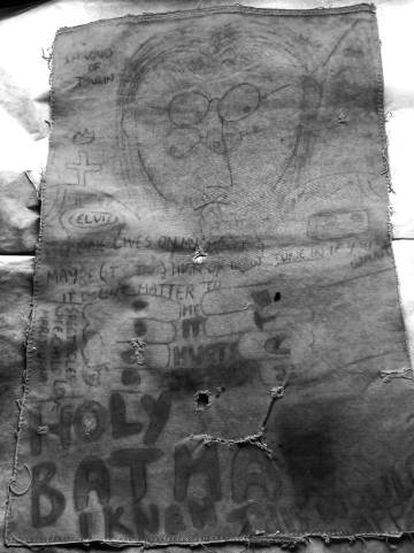The Shroud of Lennon: the musician’s hijinks during his time in Spain
In 1966, the Beatle parodied the Shroud of Turin with a scrap of cloth while filming ‘How I Won the War’ in Almería

“Christ! You know it ain't easy / You know how hard it can be / The way things are going / They're gonna crucify me,” sang John Lennon in The ballad of John and Yoko in the summer of 1969. His “crucifixion” by the US press had begun almost three years earlier, on July 29th, 1966, when the magazine Datebook published a striking quote from the Beatles frontman: “Christianity will go. It will vanish and shrink. I needn't argue about that; I'm right and I'll be proved right. We're more popular than Jesus now; I don't know which will go first—rock 'n' roll or Christianity.”

The young musician-turned-intellectual issued the quote in an interview as his way of describing society’s increasing secularization and the detachment between the youth and religion. His comments slipped by under the radar in the UK, where the interviews were first published, but in the United States they were seen by some as blasphemy and led to major controversy just before the Beatles’ third American tour. There were public bonfires of Beatles records in certain communities of the Bible Belt of the American South, and all four musicians received death threats from the Ku Klux Klan. Throughout August the atmosphere at their concerts was thick with tension, and their press conferences, once light-hearted and humorous, turned into inquisitions in which the provocative rocker had to beg forgiveness from American fans. At the end of the tour, the Beatles decided to stop giving concerts once and for all.
The comparison with Jesus proved costly for the group, but a few weeks later, Lennon took the supposed sacrilege a step further while filming in Almería, in southern Spain. He arrived there on September 19, 1966 to act in anti-war movie How I Won the War, directed by Richard Lester – but rather than escaping the scandals, he brought more with him. The fact is that he couldn’t have avoided it anyway, with journalists bringing the topic up every time he was interviewed on set. During one with Diego Segura for Spanish pop magazine Fans, when he was asked if he had been drinking when he made the controversial comment, John asked Segura not to keep reminding him.
It was there, in the deserts of Almería, where Lennon found some scrap of military tarp or canvas and set his plan into action. Blasphemy? He was going to give them blasphemy. He drew a rough portrait of his own face on the fabric, parodying the Shroud of Turin. He draped the cloth, less than a meter long, over himself during long waits between takes. After filming concluded, he gave it to Ron Lacey, a young British actor with whom he had become friends during furtive smoke breaks. “Adiós Ronnie,” he scribbled in Spanish on the rag. Years later, the actor (popular for his role as the Nazi with the Lennon-esque glasses in Raiders of the Lost Ark) gave the “shroud” to a buddy he partied with, who has held onto it to this day.
Sign up for our newsletter
EL PAÍS English Edition has launched a weekly newsletter. Sign up today to receive a selection of our best stories in your inbox every Saturday morning. For full details about how to subscribe, click here.
The auction house of Cooper Owen confirms its authenticity. Two years ago, they tried to sell it without success – perhaps because the supposed signature of the member of the world’s biggest band looks more like abstract art than an autograph. It’s difficult to believe that this scrap of thin, khaki canvas, stained with fragmented phrases and blurred strokes, is authentic. But it is.
Lennon drew himself as a stubbly Jesus, with round glasses as a crown of thorns. The caricature is styled like a rag doll you’d use to make fun of particularly stuffy professor, with the phrase Holy Batman scribbled nearby (another heretical reference for good measure), right next to an anagram of the famous superhero’s name. Under the same image, he drew two fists with the words “Love” and “Hurt” spelled out on the knuckles. On one side, John sketched three crosses and a KKK hood, and on the other side, another cross with a crown, as well as a tribute to Elvis, who had opened his eyes to rock in 1956.
The shroud of Lennon wasn’t just an irate jab from a musician who understood its boldness. It was an intimate expression of his daily feelings, tracking the progression of his mood during the six weeks of filming in Spain. In his scribblings on the fabric, he expressed a nostalgia for the past and symbols for doubts about his own life: glasses, wife, sun, love, marijuana – and then to the side, a cat. Jesus’s shadow seemed to follow the musicians up to the end of his life in his songs, comments, political leanings, and even his physical appearance. Through his act with the Shroud of Turin in Almería, Lennon continued drawing parallels between himself and Christ, albeit paradoxically.
Lennon and Jesus shared something else: an early death. In How I Won the War, his character Gripweed bleeds out on the battlefield, stating fatalistically: “I knew this'd happen.” Years later, in December of 1980, the world learned that at the age of 40, Lennon had been taken prematurely from the real world as well, raised to the altar as the first Messiah of rock.
50 year anniversary of ‘Strawberry Fields Forever’
The cloth is part of the musical puzzle and arqueological adventure of Strawberry Fields Forever, the song that Lennon wrote fifty years ago and the reason for Almería’s celebration on October 7-9, featuring music, lectures, and a speech paying homage to the musician by professor Juan Carrión, a professor who used Beatles songs to teach his students English and met Lennon in 1966. The “shroud” sheds light on the origin of that masterpiece of a song. The words towards the center of the fabric, “Nobody lives on my moon / Maybe it’s too high or too low / It doesn’t matter to me,” refer to a verse of the song, where Lennon switched out the word “tree” for the moon of the Almerían landscape. He always took the cloth with him, adding ideas as he went with the felt-tip marker he had used to correct Carrión’s papers, and showing (just like in the famous song) his pain, doubts, and even resent. Ultimately, a glimmer of hope emerged when John left Almería fo Santa Isabel on his birthday to record Strawberry Fields Forever in the garden from his childhood. But nothing after that would make it into the satirical shroud.
English version by Allison Light.












































